|
Thursday, March 6
- Breakfast: Canadian bacon, egg and cheese Texas toast
- Breakfast: corned beef hash and eggs
- California pulled-pork sandwich
- Mediterranean-style ziti with asparagus
- Honey baked ham
- Buffalo chicken tender wrap
- Grilled- or crispy-chicken salad
- White-chicken chili
- Chef's choice soup
- Assorted pizza by the slice
Wilson Hall Cafe menu |
|
Friday, March 7
Dinner
- French onion soup
- Filet with cabernet sauce
- Potatoes gratin
- Grilled asparagus
- Pear tart
Wednesday, March 12
Lunch
- Spicy pork diablo
- Sweet potato mash
- Roasted broccoli
- Flourless chocolate ancho cake
Chez Leon menu
Call x3524 to make your reservation.
|
|
A second chance at sight
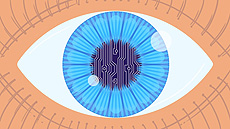 |
Silicon microstrip detectors, a staple in particle physics experiments, provide information that may be critical to restoring vision to some who lost it. Image: Sandbox Studio
|
In 1995, physicist Alan Litke co-wrote a particularly prescient article for Scientific American about potential uses for an emerging technology called the silicon microstrip detector. With its unprecedented precision, this technology was already helping scientists search for the top quark and, Litke wrote, it could help discover the elusive Higgs boson. He further speculated that it could perhaps also begin to uncover some of the many mysteries of the brain.
As the article went to press, physicists at Fermilab announced the discovery of the top quark, using those very same silicon detectors. In 2012, the world celebrated the discovery of the Higgs boson, aided by silicon microstrip detectors at CERN. Now Litke's third premonition is also coming true: His work with silicon microstrip detectors and slices of retinal tissue is leading to developments in neurobiology that are starting to help people with certain kinds of damage to their vision to see.
"The starting point and the motivation was fundamental physics," says Litke, who splits his time between University of California, Santa Cruz, and CERN. "But once you have this wonderful technology, you can think about applying it to many other fields."
Silicon microstrip detectors use a thin slab of silicon, implanted with an array of diode strips, to detect charged particles. As a particle passes through the silicon, a localized current is generated. This current can be detected on the nearby strips and measured with high spatial resolution and accuracy.
Litke and collaborators with expertise in, and inspiration from, the development of silicon microstrip detectors, fabricated two-dimensional arrays of microscopic electrodes to study the complex circuitry of the retina. In the experiments, a slice of retinal tissue is placed on top of one of the arrays. Then a movie — a variety of visual stimuli including flashing checkerboards and moving bars — is focused on the input neurons of the retina, and the electrical signals generated by hundreds of the retina's output neurons are simultaneously recorded. This electrical activity is what would normally be sent as signals to the brain and translated into visual perceptions.
Read more
—Laura Dattaro
|
Wilson Hall's shadow
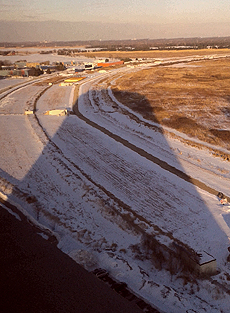 |
| Later in the afternoon at 5 p.m., Wilson Hall cast a large shadow over the Main Ring.
Photo: Elliott McCrory, AD |
|
Case for dark matter signal strengthens
From Quanta Magazine, March 3, 2014
Not long after the Fermi Gamma-ray Space Telescope took to the sky in 2008, astrophysicists noticed that it was picking up a steady rain of gamma rays pouring outward from the center of the Milky Way galaxy. This high-energy radiation was consistent with the detritus of annihilating dark matter, the unidentified particles that constitute 84 percent of the matter in the universe and that fizzle upon contact with each other, spewing other particles as they go. If the gamma rays did in fact come from dark matter, they would reveal its identity, resolving one of the biggest mysteries in physics. But some argued that the gamma rays could have originated from another source.
Now a new analysis of the signal claims to rule out all other plausible explanations and makes the case that the gamma rays trace back to a type of particle that has long been considered the leading dark matter candidate — a weakly interacting massive particle, or WIMP. Meanwhile, a more tentative X-ray signal reported in two other new studies suggests the existence of yet another kind of dark matter particle called a sterile neutrino.
Read more
|
|
Angling for new physics with leptons from top quark pairs
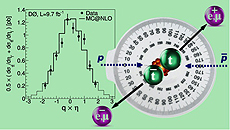 |
| In the Standard Model, pairs of top-antitop quarks are produced with a known directional bias in proton-antiproton collisions, with the top (antitop) quark following the (anti)proton direction slightly more than half of the time. By measuring the angular distributions of leptons (muons and electrons) from top quark decays, this dependence can be rigorously tested. This measurement finds good agreement between the data and Standard Model predictions (MC@NLO), as shown by the plot on the left. |
Disponible en español
The Tevatron data set, collected from proton-antiproton collisions, gives access to some unique precision tests of the Standard Model. One helpful property of the collision environment is the existence of distinct proton and antiproton directions, allowing the directional preferences of matter and antimatter production to be measured. One can classify particle production as "forward" (for example, positively charged particles following the proton direction and negatively charged particles following the antiproton direction) or "backward" (vice versa). One can then create a class of "forward-backward" asymmetry observables, which can be explored in searches for new physics.
The DZero collaboration recently published a new measurement of one such directional asymmetry, from top-antitop quark pair production. To first order, the Standard Model predicts top-antitop production to be forward-backward symmetric. However, higher-order effects introduce a small asymmetry, of a few percent, meaning that (anti)top quarks tend to be produced along the (anti)proton beam direction. Other theories beyond the Standard Model, such as so-called axigluon models, can give significant departures from the Standard Model values, generally increasing the asymmetries to larger values.
For this publication, the top and antitop quarks are both selected in the lepton channel, in particular, in their decays to a muon or electron. Rather than try to infer the direction of the original (anti)top quark, we use the directions of the charged leptons originating from the decay products of the original top and antitop quarks. For this analysis, we looked at original (anti)top quark decaying into either a muon or electron (its charge depending on whether it decayed from a top or an antitop), an undetected neutrino and a b quark jet. This decay pattern is very distinctive, giving a sample signal purity exceeding 80 percent. Both muons and electrons leave extended signatures in the detector, meaning that their trajectories are known with excellent precision, and the correspondence between the lepton and top quark direction is well-understood.
In fact, this paper measures two separate asymmetry parameters: a single lepton asymmetry (for example, how often the positive lepton follows the proton direction versus the antiproton direction) and a similarly defined dilepton asymmetry. The two quantities are highly correlated, but both their individual values and their ratio are precisely predicted by the Standard Model. After subtracting the contributions from various background processes and accounting for apparent asymmetries caused by detector effects, the final results are found to agree with the Standard Model predictions. Two possible axigluon models in particular are disfavored by the data. Stay tuned for more measurements of similar top quark asymmetries from DZero in the coming weeks.
—Mark Williams
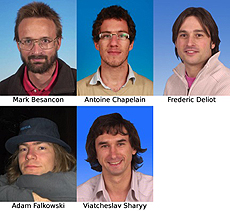 |
| These DZero members, all from CEA, Saclay, France, made significant contributions to this publication. |
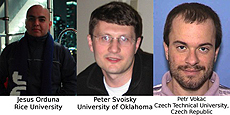 |
| The Clued0 administration team provides essential computing support for the Clued0 network of computers at DZero. This is a collection of several hundred nodes, comprising both desktop computers and dedicated processors used for parallel computing. Their duties range from fixing hardware and software issues with individual machines to coordinating software upgrades across the entire network. |
|
|